Evolution of H5-Type Avian Influenza A Virus Towards Mammalian Tropism in Egypt, 2014 to 2015
Abstract
1. Introduction
2. Results
2.1. ISM Analysis and Generation of Selected Reassortant Strains
2.2. Receptor-Binding Specificity for LP (7+1) H5 Reasstortants
2.3. Replication Efficiency of LP 7+1 Reassortants In Vitro
2.4. Pathogenicity of LP 7+1 H5-Reasstortants In Vivo
3. Discussion
4. Materials and Methods
4.1. Cells and Viruses
4.2. Sequences
4.3. The Informational Spectrum Method
4.4. The ISM-Based Phylogenetic Analysis
- For each protein sequence X calculate its informational spectrum SX:
- 1.1.
- Transformation of sequence into signal by coding of each amino acid with corresponding EIIP value;
- 1.2.
- Decrease of signal to zero mean;
- 1.3.
- Zero-padding of signal to the length of the longest signal, to set the same resolution to all spectra;
- 1.4.
- Generate the energy density spectrum by applying the fast Fourier transformation (FFT) to the signal.
- Calculate the distance matrix with the following distance measure between two protein sequences X and Y:where SX and SY are the corresponding informational spectra and N is the length of the longest sequence.
- SX and construct the tree using the unweighted pair group method with arithmetic mean (UPGMA) clustering method.
4.5. Generation of H5N1 Viruses Expressing an HA with a Monobasic Cleavage Site
4.6. Generation of Recombinant IAVs (rg-IAVs) and Determination of Replication Kinetics
4.7. Receptor Specificity Assay
4.8. Pathogenicity in Mice
4.9. Ethics Statement and Biosafety
Author Contributions
Funding
Conflicts of Interest
References
- Mostafa, A.; Abdelwhab, E.M.; Mettenleiter, T.C.; Pleschka, S. Zoonotic potential of influenza a virus: A comprehensive overview. Viruses 2018, 10, 497. [Google Scholar] [CrossRef] [PubMed]
- Kryazhimskiy, S.; Dushoff, J.; Bazykin, G.A.; Plotkin, J.B. Prevalence of epistasis in the evolution of influenza a surface protein. PLoS Genet. 2011, 7, e1001301. [Google Scholar] [CrossRef] [PubMed]
- Mair, C.M.; Ludwig, K.; Herrmann, A.; Sieben, C. Receptor binding and ph stability—How influenza a virus hemagglutinin affects host-specific virus infection. Biochim. Biophys. Acta (BBA) Biomembr. 2014, 1838, 1153–1168. [Google Scholar] [CrossRef] [PubMed]
- Schrauwen, E.J.; Richard, M.; Burke, D.F.; Rimmelzwaan, G.F.; Herfst, S.; Fouchier, R.A. Amino acid substitutions that affect receptor binding and stability of the hemagglutinin of influenza a/h7n9 virus. J. Virol. 2016, 90, 3794–3799. [Google Scholar] [CrossRef]
- Pappas, C.; Viswanathan, K.; Chandrasekaran, A.; Raman, R.; Katz, J.M.; Sasisekharan, R.; Tumpey, T.M. Receptor specificity and transmission of H2N2 subtype viruses isolated from the pandemic of 1957. PLoS ONE 2010, 5, e11158. [Google Scholar] [CrossRef]
- Rogers, G.N.; D’Souza, B.L. Receptor binding properties of human and animal H1 influenza virus isolates. Virology 1989, 173, 317–322. [Google Scholar] [CrossRef]
- Cattoli, G.; Milani, A.; Temperton, N.; Zecchin, B.; Buratin, A.; Molesti, E.; Aly, M.M.; Arafa, A.; Capua, I. Antigenic drift in H5N1 avian influenza virus in poultry is driven by mutations in major antigenic sites of the hemagglutinin molecule analogous to those for human influenza virus. J. Virol. 2011, 85, 8718–8724. [Google Scholar] [CrossRef]
- El-Shesheny, R.; Kandeil, A.; Bagato, O.; Maatouq, A.M.; Moatasim, Y.; Rubrum, A.; Song, M.S.; Webby, R.J.; Ali, M.A.; Kayali, G. Molecular characterization of avian influenza h5n1 virus in Egypt and the emergence of a novel endemic subclade. J. Gen. Virol. 2014, 95, 1444–1463. [Google Scholar] [CrossRef]
- WHO. Cumulative Number of Confirmed Human Cases for Avian Influenza A (H5N1) Reported to Who, 2003–2015. Available online: https://www.who.int/influenza/human_animal_interface/2016_01_20_tableH5N1.pdf?ua=1 (accessed on 20 January 2016).
- Perovic, V.R.; Muller, C.P.; Niman, H.L.; Veljkovic, N.; Dietrich, U.; Tosic, D.D.; Glisic, S.; Veljkovic, V. Novel phylogenetic algorithm to monitor human tropism in Egyptian H5N1-HPAIV reveals evolution toward efficient human-to-human transmission. PLoS ONE 2013, 8, e61572. [Google Scholar] [CrossRef]
- Veljkovic, V.; Cosic, I.; Dimitrijevic, B.; Lalovic, D. Is it possible to analyze DNA and protein sequences by the methods of digital signal processing? IEEE Trans. Biomed. Eng. 1985, 32, 337–341. [Google Scholar] [CrossRef]
- Veljkovic, V.; Niman, H.L.; Glisic, S.; Veljkovic, N.; Perovic, V.; Muller, C.P. Identification of hemagglutinin structural domain and polymorphisms which may modulate swine H1N1 interactions with human receptor. BMC Struct. Biol. 2009, 9, 62. [Google Scholar] [CrossRef] [PubMed][Green Version]
- Schmier, S.; Mostafa, A.; Haarmann, T.; Bannert, N.; Ziebuhr, J.; Veljkovic, V.; Dietrich, U.; Pleschka, S. In silico prediction and experimental confirmation of HA residues conferring enhanced human receptor specificity of H5N1 influenza a virus. Sci. Rep. 2015, 5, 11434. [Google Scholar] [CrossRef] [PubMed]
- Matrosovich, M.; Matrosovich, T.; Uhlendorff, J.; Garten, W.; Klenk, H.D. Avian-virus-like receptor specificity of the hemagglutinin impedes influenza virus replication in cultures of human airway epithelium. Virology 2007, 361, 384–390. [Google Scholar] [CrossRef] [PubMed]
- Matrosovich, M.; Matrosovich, T.; Carr, J.; Roberts, N.A.; Klenk, H.D. Overexpression of the alpha-2,6-sialyltransferase in MDCK cells increases influenza virus sensitivity to neuraminidase inhibitors. J. Virol. 2003, 77, 8418–8425. [Google Scholar] [CrossRef] [PubMed]
- WHO. Cumulative Number of Confirmed Human Cases for Avian Influenza A (H5N1) Reported to Who, 2003–2019. Available online: https://www.who.int/influenza/human_animal_interface/H5N1_cumulative_table_archives/en/ (accessed on 27 September 2019).
- Shao, W.; Li, X.; Goraya, M.U.; Wang, S.; Chen, J.L. Evolution of influenza a virus by mutation and re-assortment. Int. J. Mol. Sci. 2017, 18, 1650. [Google Scholar] [CrossRef]
- Watanabe, Y.; Ibrahim, M.S.; Ellakany, H.F.; Kawashita, N.; Mizuike, R.; Hiramatsu, H.; Sriwilaijaroen, N.; Takagi, T.; Suzuki, Y.; Ikuta, K. Acquisition of human-type receptor binding specificity by new H5N1 influenza virus sublineages during their emergence in birds in Egypt. PLoS Pathog. 2011, 7, e1002068. [Google Scholar] [CrossRef]
- Guo, F.; Li, Y.; Yu, S.; Liu, L.; Luo, T.; Pu, Z.; Xiang, D.; Shen, X.; Irwin, D.M.; Liao, M.; et al. Adaptive evolution of human-isolated H5Nx avian influenza a virus. Front. Microbiol. 2019, 10, 1328. [Google Scholar] [CrossRef]
- Arafa, A.S.; Naguib, M.M.; Luttermann, C.; Selim, A.A.; Kilany, W.H.; Hagag, N.; Samy, A.; Abdelhalim, A.; Hassan, M.K.; Abdelwhab, E.M.; et al. Emergence of a novel cluster of influenza A(H5N1) virus clade 2.2.1.2 with putative human health impact in Egypt, 2014/15. Eurosurveill 2015, 20, 2–8. [Google Scholar] [CrossRef]
- Arafa, A.; El-Masry, I.; Kholosy, S.; Hassan, M.K.; Dauphin, G.; Lubroth, J.; Makonnen, Y.J. Phylodynamics of avian influenza clade 2.2.1 H5N1 viruses in Egypt. Virol. J. 2016, 13, 49. [Google Scholar] [CrossRef]
- Watanabe, Y.; Arai, Y.; Daidoji, T.; Kawashita, N.; Ibrahim, M.S.; El-Gendy Eel, D.; Hiramatsu, H.; Kubota-Koketsu, R.; Takagi, T.; Murata, T.; et al. Characterization of H5N1 influenza virus variants with hemagglutinin mutations isolated from patients. MBio 2015, 6, e00081-15. [Google Scholar] [CrossRef]
- Imai, M.; Watanabe, T.; Hatta, M.; Das, S.C.; Ozawa, M.; Shinya, K.; Zhong, G.; Hanson, A.; Katsura, H.; Watanabe, S.; et al. Experimental adaptation of an influenza H5 HA confers respiratory droplet transmission to a reassortant H5 HA/H1N1 virus in ferrets. Nature 2012, 486, 420–428. [Google Scholar] [CrossRef] [PubMed]
- NCBI. National Center for Biotechnology Information (ncbi) Database; NCBI: Bethesda, MD, USA, 2015. [Google Scholar]
- GISAID. Global Initiative on Sharing All Influenza Data (gisaid) Database; GISAID: Münche, Germany, 2015. [Google Scholar]
- Veljkovic, V.; Slavic, I. Simple general-model pseudopotential. Phys. Rev. Lett. 1972, 29, 105–107. [Google Scholar] [CrossRef]
- Veljkovic, V. The dependence of the fermi energy on the atomic number. Phys. Lett. A 1973, 45, 41–42. [Google Scholar] [CrossRef]
- Veljkovic, V. A Theoretical Approach to the Preselection of Carcinogens and Chemical Carcinogenesis; Gordon and Breach Science Publishers: New York, NY, USA, 1980; p. 114. [Google Scholar]
- Veljkovic, V.; Paessler, S.; Glisic, S.; Prljic, J.; Perovic, V.R.; Veljkovic, N.; Scotch, M. Evolution of 2014/15 H3N2 influenza viruses circulating in us: Consequences for vaccine effectiveness and possible new pandemic. Front. Microbiol. 2015, 6, 1456. [Google Scholar] [CrossRef] [PubMed]
- Hoffmann, E.; Stech, J.; Guan, Y.; Webster, R.G.; Perez, D.R. Universal primer set for the full-length amplification of all influenza a virus. Arch. Virol. 2001, 146, 2275–2289. [Google Scholar] [CrossRef]
- Mostafa, A.; Kanrai, P.; Petersen, H.; Ibrahim, S.; Rautenschlein, S.; Pleschka, S. Efficient generation of recombinant influenza a viruses employing a new approach to overcome the genetic instability of HA segments. PLoS ONE 2015, 10, e0116917. [Google Scholar] [CrossRef]
- Mostafa, A.; Kanrai, P.; Ziebuhr, J.; Pleschka, S. Improved dual promotor-driven reverse genetics system for influenza viruses. J. Virol. Methods 2013, 193, 603–610. [Google Scholar] [CrossRef]
- Neumann, G.; Watanabe, T.; Ito, H.; Watanabe, S.; Goto, H.; Gao, P.; Hughes, M.; Perez, D.R.; Donis, R.; Hoffmann, E.; et al. Generation of influenza a virus entirely from cloned cDNAs. Proc. Natl. Acad. Sci. USA 1999, 96, 9345–9350. [Google Scholar] [CrossRef]
- Hoffmann, E.; Neumann, G.; Kawaoka, Y.; Hobom, G.; Webster, R.G. A DNA transfection system for generation of influenza a virus from eight plasmids. Proc. Natl. Acad. Sci. USA 2000, 97, 6108–6113. [Google Scholar] [CrossRef]
- Reed, L.J.; Muench, H. A simple method of estimating fifty per cent endpoints. Am. J. Epidemiol. 1938, 27, 493–497. [Google Scholar] [CrossRef]
- Matrosovich, M.N.; Gambaryan, A.S. Solid-phase assays of receptor-binding specificity. Methods Mol. Biol. 2012, 865, 71–94. [Google Scholar] [PubMed]
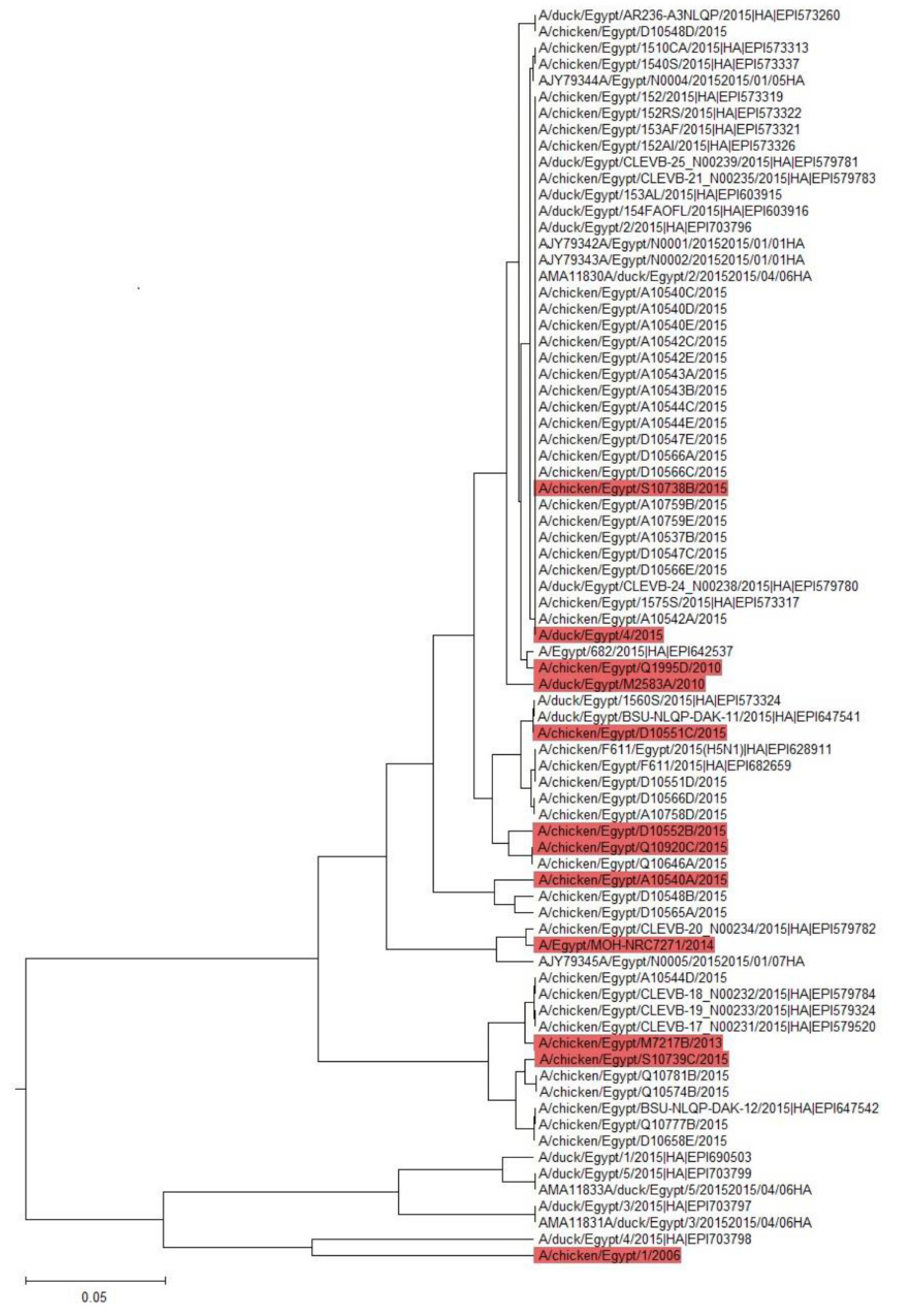
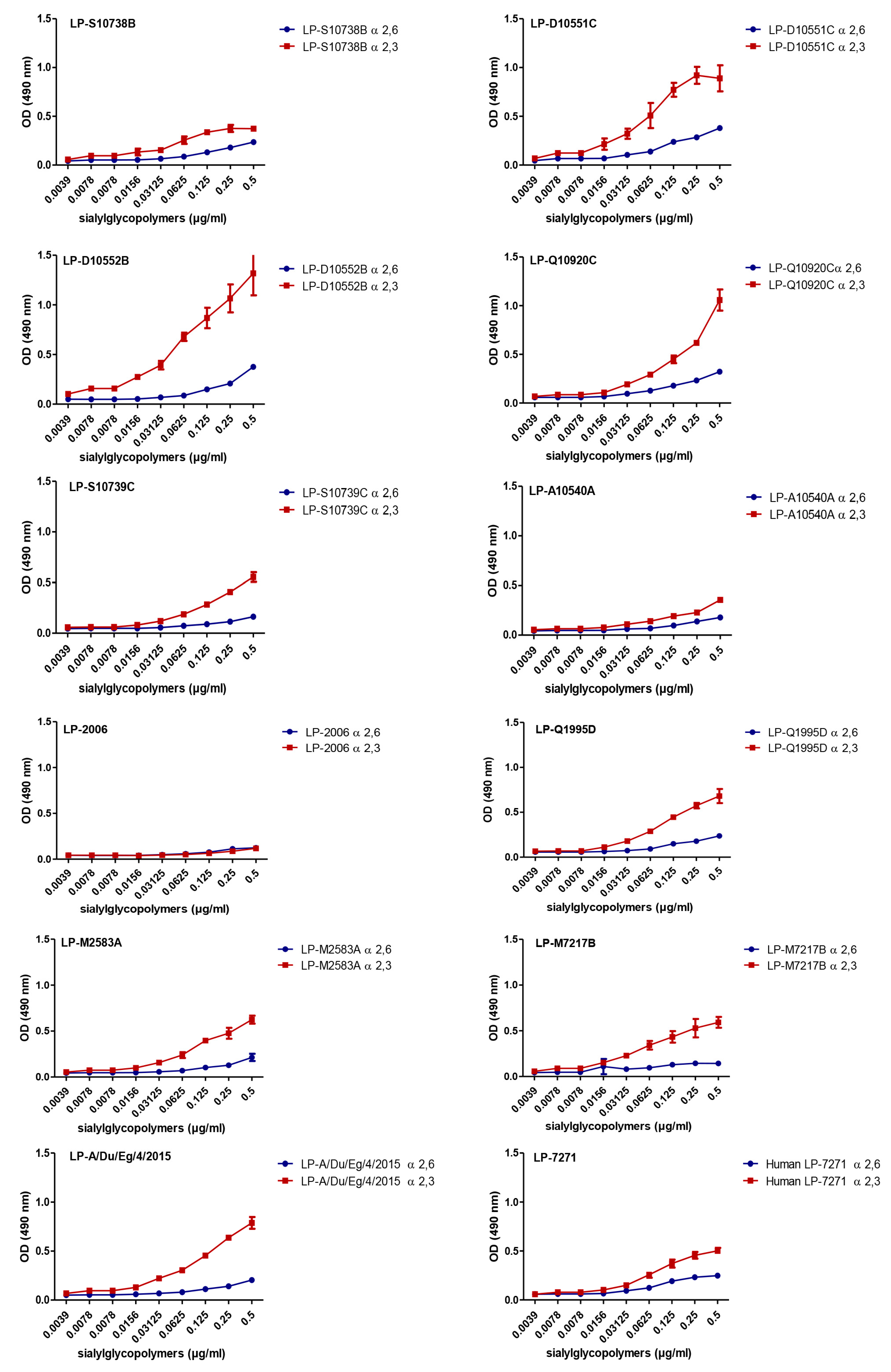
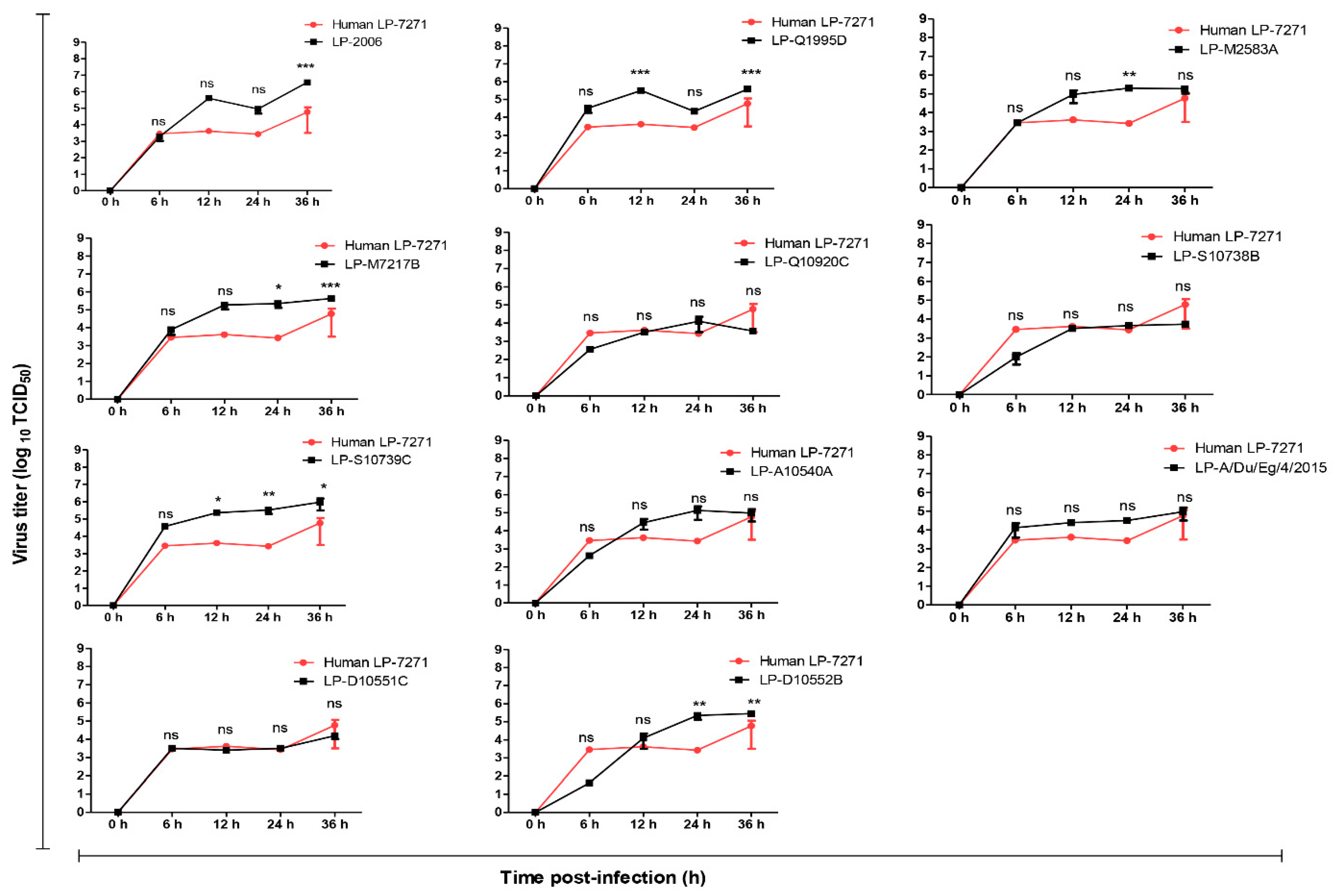
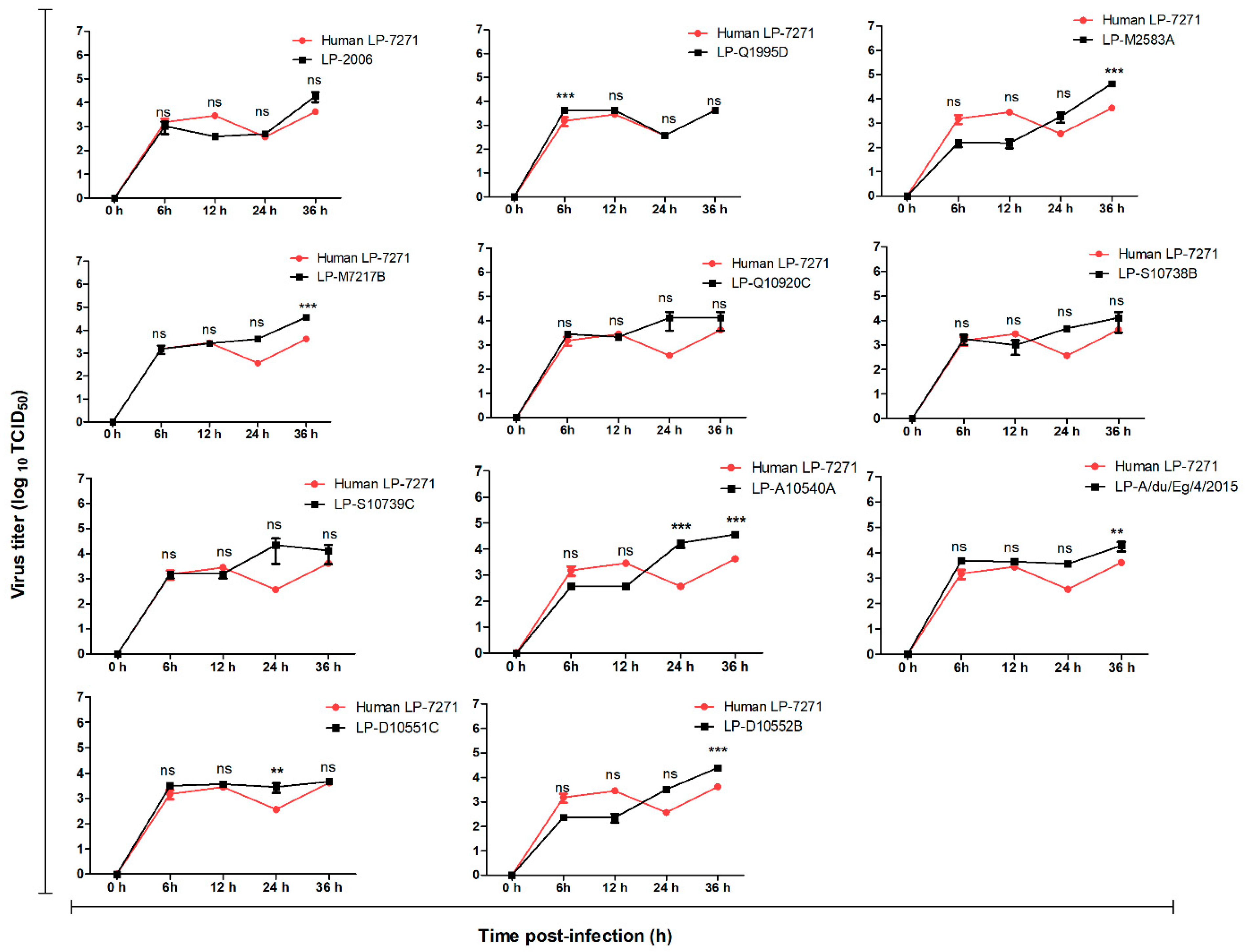

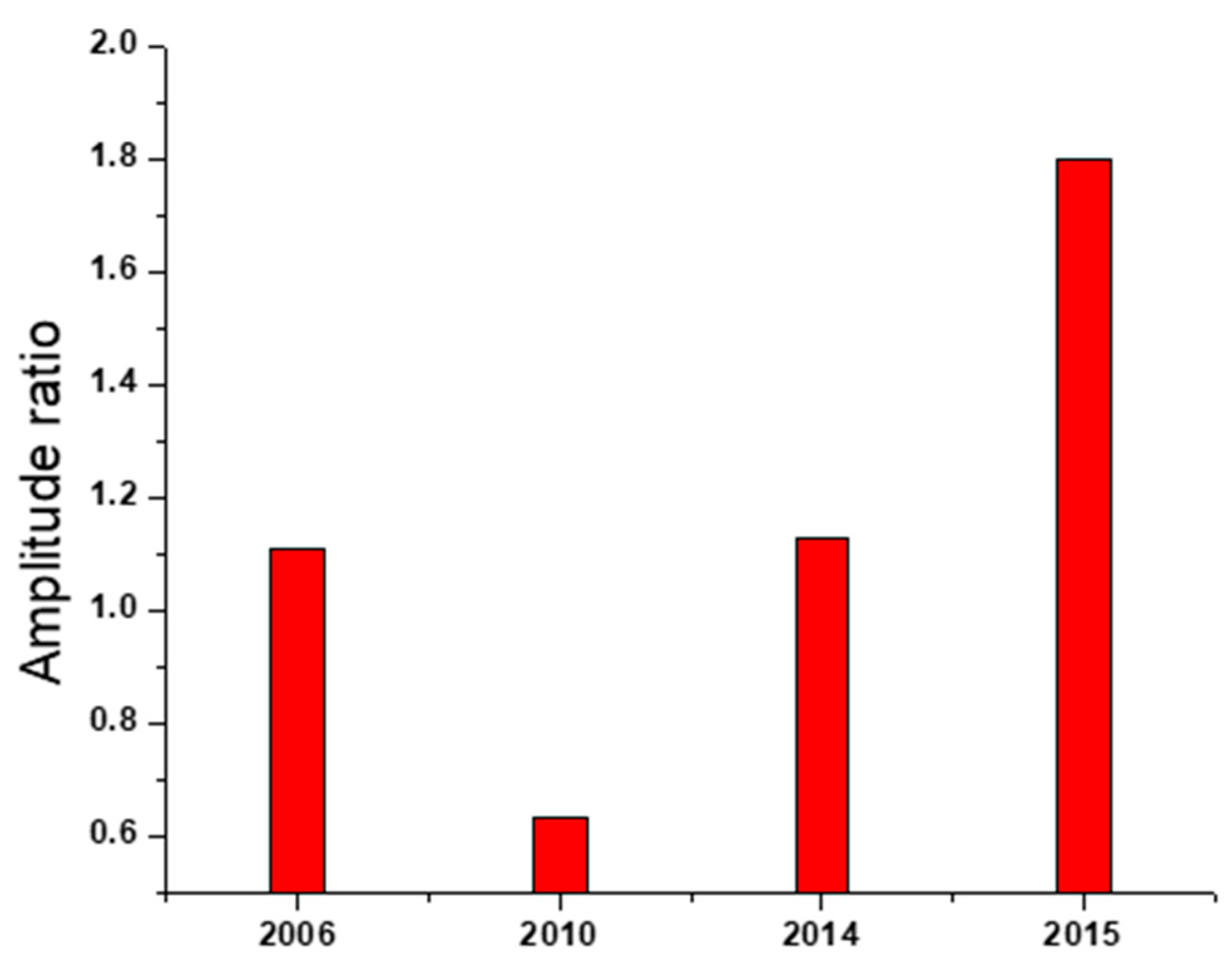
| rg-H5N1 Strains | Clade | 7+1 LP (TCID50/100 µL) |
|---|---|---|
| A/ chicken/ Egypt/1/2006 | 2.2.1 | 105.8 |
| A/chicken/ Egypt/Q1995D/2010 | 2.2.1.1 | 104.8 |
| A/duck/Egypt/M2583A/2010 | 2.2.1.1 | 106.4 |
| A/chicken/Egypt/M7217B/2013 | 2.2.1.2 | 105.8 |
| A/chicken/Egypt/A10540A/2014 | 2.2.1.2 | 105.3 |
| A/chicken/Egypt/D10548D/2014 | 2.2.1.2 | 105.12 |
| A/chicken/Egypt/D10551C/2014 | 2.2.1.2 | 104.3 |
| A/chicken/Egypt/D10552B/2015 | 2.2.1.2 | 102.42 |
| A/chicken/Egypt/S10738B/2015 | 2.2.1.2 | 105.2 |
| A/chicken/Egypt/S10739C/2015 | 2.2.1.2 | 105.3 |
| A/chicken/Egypt/Q10920C/2015 | 2.2.1.2 | 104.8 |
| A/duck/Egypt/4/2015 | 2.2.1.2 | 105.12 |
| A/ Egypt/MOH-NRC7271/2014 | 2.2.1.2 | 104.9 |
| H5N1 Strain | Clade | Amino Acid (aa) Variations * | |||||||||||||||
|---|---|---|---|---|---|---|---|---|---|---|---|---|---|---|---|---|---|
| 4 | 12 | 43 | 94 | 120 | 129 | 151 | 154 | 155 | 189 | 193 | 296 | 322 | 373 | 507 | 537 | ||
| 2006 | 2.2.1 | C | S | D | N | S | S | I | D | N | R | N | L | Q | K | V | F |
| Q1995D/2010 | 2.2.1.1 | C | S | D | N | S | S | I | N | N | R | N | L | Q | K | V | F |
| M2583A/2010 | 2.2.1.1 | C | S | N | N | D | - | T | N | D | R | N | L | Q | K | I | S |
| M7217B/2013 | 2.2.1.2 | C | S | N | N | D | - | T | S | D | R | N | L | Q | K | I | F |
| A10540A/2014 | 2.2.1.2 | C | S | N | N | D | - | T | N | D | M | S | L | Q | R | I | S |
| D10551C/2014 | 2.2.1.2 | C | S | N | N | D | - | T | N | G | R | N | L | K | R | I | S |
| D10552B/2015 | 2.2.1.2 | G | W | N | N | D | - | T | N | G | R | N | L | K | R | I | S |
| S10738B/2015 | 2.2.1.2 | C | S | N | N | D | - | T | N | D | R | N | L | Q | K | I | F |
| S10739C/2015 | 2.2.1.2 | G | S | N | N | D | - | T | N | D | R | N | F | Q | K | I | F |
| Q10920C/2015 | 2.2.1.2 | C | S | N | T | D | - | T | N | D | R | N | L | Q | R | I | S |
| A/duck/Egypt/4/2015 | 2.2.1.2 | C | S | N | N | D | - | T | N | D | R | N | L | Q | R | I | S |
| Human LP-7271/2014 | 2.2.1.2 | C | S | N | N | D | - | T | N | D | R | N | L | Q | R | I | S |
© 2019 by the authors. Licensee MDPI, Basel, Switzerland. This article is an open access article distributed under the terms and conditions of the Creative Commons Attribution (CC BY) license (http://creativecommons.org/licenses/by/4.0/).
Share and Cite
Mahmoud, S.H.; Mostafa, A.; El-Shesheny, R.; Seddik, M.Z.; Khalafalla, G.; Shehata, M.; Kandeil, A.; Pleschka, S.; Kayali, G.; Webby, R.; et al. Evolution of H5-Type Avian Influenza A Virus Towards Mammalian Tropism in Egypt, 2014 to 2015. Pathogens 2019, 8, 224. https://doi.org/10.3390/pathogens8040224
Mahmoud SH, Mostafa A, El-Shesheny R, Seddik MZ, Khalafalla G, Shehata M, Kandeil A, Pleschka S, Kayali G, Webby R, et al. Evolution of H5-Type Avian Influenza A Virus Towards Mammalian Tropism in Egypt, 2014 to 2015. Pathogens. 2019; 8(4):224. https://doi.org/10.3390/pathogens8040224
Chicago/Turabian StyleMahmoud, Sara Hussein, Ahmed Mostafa, Rabeh El-Shesheny, Mohamed Zakaraia Seddik, Galal Khalafalla, Mahmoud Shehata, Ahmed Kandeil, Stephan Pleschka, Ghazi Kayali, Richard Webby, and et al. 2019. "Evolution of H5-Type Avian Influenza A Virus Towards Mammalian Tropism in Egypt, 2014 to 2015" Pathogens 8, no. 4: 224. https://doi.org/10.3390/pathogens8040224
APA StyleMahmoud, S. H., Mostafa, A., El-Shesheny, R., Seddik, M. Z., Khalafalla, G., Shehata, M., Kandeil, A., Pleschka, S., Kayali, G., Webby, R., Veljkovic, V., & Ali, M. A. (2019). Evolution of H5-Type Avian Influenza A Virus Towards Mammalian Tropism in Egypt, 2014 to 2015. Pathogens, 8(4), 224. https://doi.org/10.3390/pathogens8040224










